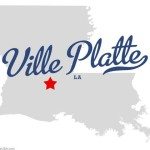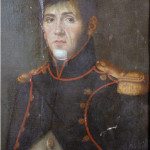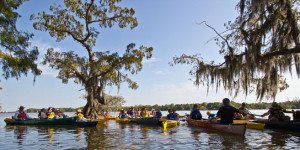How Ville Platte got its somewhat unique name remains obscure in the minds of would-be historians seeking the solution thereof. Notations on the original plats of survey for the area that is now Ville Platte stated that surveyors had to use pirogues and flat boats to properly do their work.
Consequently, those surveyors referred to it as ‘Flat Ville’ or ‘Flat Town’, both of which, when translated into French, should be “Ville Plat” but wound up ‘Ville Platte’. However, the name Ville Platte could have come from another source. In its early inception, the hamlet of Ville Platte was the first community on level land met by stagecoach travelers coming from the North. Conversely, it was the last level settled area seen by travelers journeying northward from Baton Rouge and Opelousas. North of it were the hills of North Louisiana and south of it was the Gulf Coastal Plain.The area around Ville Platte appears to have been first settled during the last half of the eighteenth century when Louisiana was under Spanish rule. The earliest record of settlement in the immediate area of Ville Platte was in the 1780’s.
Popular legend states the founder of Ville Platte was Marcellin Garand, an adjutant major in the Army of the French Empire, during the time of Napoleon. In 1824, Garand obtained one of the first two lots that were platted in what is now Ville Platte; a Doctor Robert Windex obtained the other lot. Those lots were obtained from the estate of William O’Donegan. This appears to be the actual beginning of, or the founding of, the present town of Ville Platte. The lots were located on the south side of the road that is today’s Main Street. Marcellin Garand operated a store and a tavern at the location that is today’s Evangeline Parish Library. It was a stopping place for travelers traveling from Opelousas to Alexandria. In the same local area was a blacksmith shop operated by a William Knox. A John McDaniel operated a place where lodging could be obtained.
This road upon which Ville Platte had its beginning was probably a much-traveled road. It was a somewhat ancient royal road in Spain’s New World Empire. This Spanish Trail came from the South of Opelousas and flowed northward through Bayou Chicot, Alexandria, Natchitoches, then on westward through Texas to San Antonio and thence to California, all areas at one time dominated by Spanish influence.
The first post office in Ville Platte was established in 1842 with Marcellin Garand as postmaster from then to 1848.
During this early period, the community functioned as a small trading center for the agricultural areas. The scattered inhabitants of the area were of French and Spanish extraction, but mostly French. There was also a sprinkling of English and Irish descendants who had probably migrated to Spain or France; the Irish seeking refuge when many Catholics were being persecuted in Ireland.
Being situated in a low-lying area, the community of Ville Platte suffered considerably from heavy rains flooding its main thoroughfare and outlying country roads. It was not until the 1920’s (some 65 years after the incorporation in 1854) that Ville Platte saw its first graveled road. The paving of the town’s main street was not until 1930 when the road from Opelousas to Ville Platte was finally paved.
Ville Platte was incorporated on March 16th, 1858 by an act of the Louisiana Legislature, during the administration of Governor Robert C. Wickliffe. Act No. 97 of 1858, as it was known, was written in both French and English. The act made no provision for a mayor; there were five councilmen, and from their number they selected a ‘president of the council’. This remained the state of affairs until 1912 when Ville Platte volunteered to come under the general act governing Louisiana municipalities.
Residents of Ville Platte and the surrounding area were, and are today, predominantly Catholic. The Catholic Church was first established in Ville Platte in 1854. Education was sporadic in the area until the 1880’s when the Evangeline Academy was founded. In 1911 when Evangeline Parish was created out of Imperial St. Landry, the Academy became Ville Platte High School. With the creation of this new parish of Evangeline, Ville Platte was made the parish seat of government, a factor that was bound to cause an increase in the town’s population.
In 1900, Ville Platte had a population of 163. When the railroad came to Ville Platte in 1907, the community began to grow and develop. The town had now lost its ‘one-street’ status, and streets were laid out in a grid pattern, many of them dead-ending on Main Street. By 1910, the population had reached 603. By 1920, the number was a little over 1350.
It was in 1930 to 1940 that Ville Platte had its first boom. The population jumped from 1722 in 1930 to 3721 in 1940. This was due largely to the discovery of oil in the Tate Cove area about six miles north of Ville Platte. World War II served to increase the boom, and by 1950 the population reached the neighborhood of 6600. The discovery of oil brought about the establishment of oil field industries and a carbon black plant providing more employment opportunities for the Ville Platte citizens.
 It took the discovery of oil in the immediate area and the effects of World War II to pull Ville Platte out of the dumps it was in, as a result of the Great Depression.
It took the discovery of oil in the immediate area and the effects of World War II to pull Ville Platte out of the dumps it was in, as a result of the Great Depression.
Another major accomplishment beneficial to Ville Platte’s economy was the creation of Chicot State Park, about seven miles north of the city. The park consists of 6500 acres of wooded area and rolling hills. Therein you’ll find a 2,500-acre lake studded with cypress trees. It is now known as Louisiana’s largest state park and is visited by thousands of people from all parts of the U.S.
Today, Ville Platte is rich in history, legend, agriculture, timber, natural resources, and in dedicated people. It is a colorful little city situated about 80 miles west of Baton Rouge and 45 miles south of Alexandria, on U.S. Highway 167. Its population is now slightly over 10,000.
For More Information On Area Attractions:






0 Comments